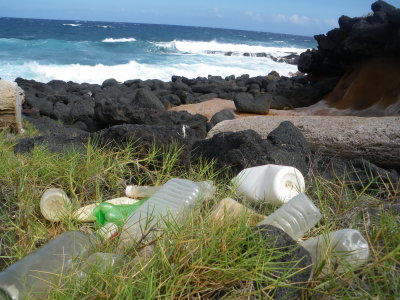by Thomas Maes (1)
What is marine litter?

Some of us might wonder what marine litter is exactly and where it comes from. We all know the term “litter” and have seen it in some kind of form in our daily lives; an empty plastic bag drifting in the wind, cigarette butts on the pavements, empty drink bottles in the park or even remote idyllic places wasted by the presence of litter. What we see on land is not different from what is going on in the sea and thus the term “Marine Litter” has been introduced to describe discarded, disposed of, or abandoned man-made objects present in the marine and coastal environment. It consists of articles that have been made or used by people and, subsequently, deliberately discarded or accidentally lost. They originate from ocean-based (fishing vessels, cargo ships, stationary platforms, fish farming installations, pleasure crafts and other vessels) or land-based sources (littering, dumping, poor waste management practices, untreated sewage and storm water discharges, riverine inputs, industrial facilities, tourism, extreme natural events) and can be found all around the globe. Most sources of marine pollution are land based and some studies indicate that up to 80% of marine litter originates from land.
Marine litter, mainly plastic, poses a serious environmental threat to marine organisms, as well as a series of economical and social problems. The majority of marine debris is comprised of plastic materials — 60-80% overall and 90% of floating debris. About 70% of our planet is covered by water that is divided into several oceans and smaller seas, all connected and all dependent on each other. Because it is the principal component of Earth's hydrosphere, the world ocean is also integral to all known life, forms an integrated part of all cycles, and influences climate and weather patterns. This means that plastic waste of all sizes and shapes became a transboundary pollution problem with a powerful vehicle, the ocean!
How did it get so bad?

Consumerism, a social and economic order based on fostering a desire to purchase goods and services in even greater amounts, has been pushing society towards an ever-growing demand for plastic and single use items, which in turn has led to an accumulation of waste products all over the planet. From a young age onwards waste has been categorised as something dirty and worthless and thus humankind created landfills and garbage dumps where on a daily basis tonnes and tonnes of items gather to spend their end of life. The constantly expanding amounts of waste and slow degradability eventually led to an enormous surplus of mainly synthetic polymers commonly known as plastics. We gradually filled up the landfills and contaminated our waterways and rivers that connect the land to the sea and slowly but surely spoiled the marine environment with discarded man-made substances. Nowadays three times more rubbish is dumped into the world’s oceans each year as the weight of fish caught annually.
Since 1950, globally there has been an average annual increase in the production and consumption of plastics of 9%. From 1.5 million tonnes in 1950, total global production reached 245 million tonnes in 2008 and it will continue to grow, reaching over 365 million tons in 2015 and 540 million tons in 2020 (using a conservative annual rate of 6.5%). An analysis of plastic materials consumption on a per capita basis shows that this has now grown to approximately 100kg per year in NAFTA and Western Europe. These regions have the potential to grow to approximately 140kg per capita by 2015. The biggest potential growth area is the rapidly developing Asian countries (excluding Japan), where current per capita consumption is only around 20kg (2).
It is estimated that around 2.25 million pieces of litter are dropped in the UK every day, while an estimated 28.5 million tonnes of waste was collected in England alone every year (DEFRA 2008 figures). Evidence shows that a single one-litre soda bottle could break down into enough fragments to put one fragment on every mile of beach in the entire world. Consequently the density of plastic litter found on UK beaches has increased by 146% between 1994 and 2008. Small plastic pieces have been the number one item found since 1998. At least one item of litter is found on every 50 cm of beach in the UK (MCS Beachwatch Survey). When asked, 48% of the UK population admit to dropping litter, but remarkably 94% of the people thought dropping litter was a fairly or very irritating behaviour. In terms of enforcement only 44,000 fixed penalty notices were issued for littering offences in 2007/2008, which is negligible when compared to the amount of people admitting to litter (3).
(1) This commentary reflects the personal opinions of the author and is not intended to represent the opinions of Cefas or other agencies of the UK government.
(2) http://www.plasticseurope.org/Documents/Document/20100225141556-Brochure_UK_FactsFigures_2009_22sept_6_Final-20090930-001-EN-v1.pdf
(3) http://www.keepbritaintidy.org/KeyIssues/Litter/Default.aspx








